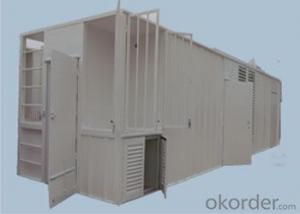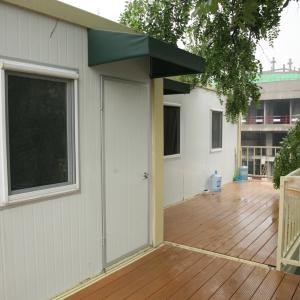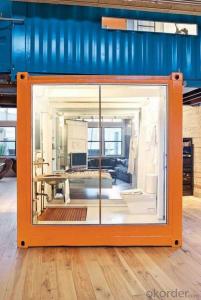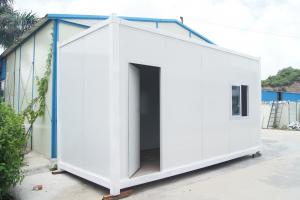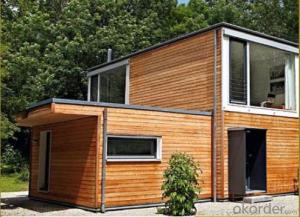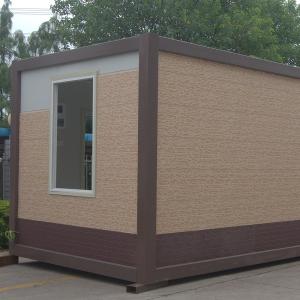container homes luxury
- Loading Port:
- Tianjin
- Payment Terms:
- TT OR LC
- Min Order Qty:
- -
- Supply Capability:
- 20000 Set set/month
OKorder Service Pledge
Quality Product, Order Online Tracking, Timely Delivery
OKorder Financial Service
Credit Rating, Credit Services, Credit Purchasing
You Might Also Like
20 Feet High Quality Prefabricated Container House
20'FT Container house with bathroom facility
| component | long beam | 3mm galvanized |
| short beam | 2.5mm galvanized | |
| column | 3mm galvanized | |
| wall panel | 75mm EPS sandwich board | |
| roof panel | 75mm PU sandwich board | |
| secondary beam | Z-shaped galvanized steel iron | |
| roof insulation | 75mm polyurethane | |
| Floor panel | 18mm plywood panel+12mm laminated floor or 20mm cement-fiber +2mm PVC | |
| door | Steel Security door,740mmx1950mm | |
| window | PVC Sliding window with Rolling shutter,1100mmx800mm | |
| electronics, water supply and drainage | according to the local law | |
| furniture and appliance | Customized-made to your requirements |
- Q:Are container houses suitable for co-working or shared office spaces?
- Yes, container houses can be suitable for co-working or shared office spaces. These structures are highly versatile and can be easily modified to accommodate different needs. With proper insulation, ventilation, and design, container houses can provide a comfortable and functional workspace for multiple individuals or businesses. Additionally, container houses offer cost-effective and sustainable solutions, which can be particularly beneficial for co-working or shared office spaces looking for affordable and eco-friendly options.
- Q:Are container houses suitable for eco-resorts?
- Yes, container houses are suitable for eco-resorts for several reasons. Firstly, container houses are a sustainable and eco-friendly option as they repurpose old shipping containers, giving them a new life instead of letting them go to waste. This helps reduce the demand for new construction materials and minimizes environmental impact. Secondly, container houses are highly energy-efficient. With proper insulation and ventilation, they can maintain comfortable temperatures without excessive energy consumption. This is particularly important for eco-resorts that aim to minimize their carbon footprint and promote sustainable practices. Additionally, container houses can be easily integrated into the natural landscape of an eco-resort. They can be arranged in various configurations, allowing for a harmonious blend with the surrounding environment. This ensures that the resort maintains a low visual impact and preserves the natural beauty of the area. Moreover, container houses offer flexibility and scalability to eco-resorts. As the demand for accommodation fluctuates, additional container units can be added or removed, providing the opportunity for efficient space management. This adaptability allows eco-resorts to optimize their resources and reduce waste. Lastly, container houses are often affordable compared to traditional construction methods. This could make eco-resorts more accessible to a wider range of travelers, promoting sustainable tourism and raising awareness about environmental issues. In conclusion, container houses are a suitable and sustainable option for eco-resorts. They offer environmental benefits, energy efficiency, integration with nature, flexibility, and affordability. By incorporating container houses into their design, eco-resorts can enhance their commitment to sustainability and provide guests with a unique and eco-friendly experience.
- Q:Can container houses be designed with a home theater?
- Yes, container houses can definitely be designed with a home theater. With proper planning and design, container houses can accommodate all types of rooms, including a home theater. The compact nature of container houses may require some creative solutions, such as utilizing space-saving technologies and multi-purpose furniture, but it is absolutely possible to incorporate a home theater into the design of a container house.
- Q:Are container houses safe from extreme weather conditions?
- Container houses can be designed and built to be safe and secure in extreme weather conditions. With proper insulation, reinforced structures, and additional features, container houses can withstand hurricanes, earthquakes, and other natural disasters. Some container homes are even designed to meet stringent building codes for high wind zones and seismic activity. One of the main advantages of container houses is their durability. Shipping containers are made of strong steel, designed to withstand the harsh conditions of sea transport. This inherent strength makes them resistant to wind, rain, and even fire. However, it is important to note that modifications and reinforcements are often necessary to ensure their safety in extreme weather conditions. For instance, container homes can be insulated with high-quality materials to provide effective thermal insulation, preventing heat loss or gain during extreme temperatures. Insulation also helps regulate the temperature inside the house, making it comfortable and safe to live in. In areas prone to hurricanes or tornadoes, container houses can be further secured by anchoring them to a solid foundation or using reinforced concrete footings. Additionally, adding storm shutters or impact-resistant windows can protect against flying debris during severe weather events. Earthquake-prone regions require additional precautions. Engineers can strengthen the container structure by welding or bolting steel beams to the containers to increase their stability. Proper seismic bracing and foundation design can ensure that the container home remains intact during an earthquake. It is crucial to work with experienced architects, engineers, and contractors who specialize in container homes, as they will have the expertise to design and construct a safe dwelling. By following proper building codes and regulations, container houses can provide a secure and reliable living space even in the face of extreme weather conditions.
- Q:How durable are container houses?
- Container houses are renowned for their durability and strength, as they are constructed using corten steel, a material known for its resilience and resistance to corrosion. This steel is specifically designed to endure harsh weather conditions, which makes it ideal for container housing. Moreover, container houses are engineered to withstand transportation and stacking. They are designed to be stacked up to nine containers high, showcasing their ability to handle substantial weight and pressure. Furthermore, container houses are built to have a long lifespan. With proper maintenance and care, these structures can last for 25 to 30 years, or even longer. The steel frames are resistant to pests, mold, and fire, further enhancing their durability. When it comes to structural integrity, container houses can endure strong winds and even earthquakes. Their solid steel structure provides stability and strength, ensuring the safety of those inside. However, it is important to acknowledge that the durability of container houses can vary depending on the construction methods and quality of materials. Proper insulation, sealing, and regular maintenance are crucial to guarantee longevity and prevent potential issues. In conclusion, container houses are exceptionally durable structures. With their robust steel frames and resistance to various environmental factors, these houses can withstand the test of time and provide a secure and safe living space for their occupants.
- Q:Are container houses prone to condensation or moisture issues?
- The occurrence of condensation and moisture problems in container houses depends largely on their design, construction, and upkeep. Steel, the material used to make containers, is highly conductive and can easily transfer heat and cold. This means that without adequate insulation, container houses can experience temperature differences between the interior and exterior, resulting in condensation. To mitigate condensation and moisture problems, several measures can be implemented. Insulation plays a crucial role in regulating the container's temperature, preventing temperature disparities that lead to condensation. Additionally, proper ventilation is essential for moisture to escape and maintain a balanced humidity level. The location of the container house is another factor to consider. If it is situated in a humid environment or an area prone to heavy rainfall, moisture problems may be more prevalent. Installing adequate drainage systems, waterproofing measures, and conducting regular inspections can help prevent water infiltration and subsequent moisture issues. Moreover, regular maintenance is vital in addressing potential sources of moisture. This includes checking for leaks, repairing damaged insulation, and ensuring the proper functioning of the ventilation system. Regular monitoring of humidity levels inside the container can also aid in identifying and resolving condensation issues before they worsen. In conclusion, while container houses can be susceptible to condensation and moisture problems, implementing proper insulation, ventilation, considering the location, and conducting regular maintenance can significantly reduce these issues.
- Q:Are container houses suitable for areas with limited access to medical facilities?
- Container houses can be a suitable housing option for areas with limited access to medical facilities. These houses are sturdy, cost-effective, and can be easily transported to remote locations. In such areas, where conventional housing options may be limited, container houses can provide a safe and comfortable living space. However, it is important to consider the specific needs of individuals living in these areas, especially in terms of medical care. While container houses can offer decent living conditions, they do not address the lack of medical facilities directly. It is crucial to provide alternative solutions to ensure the availability of medical aid in these areas. One possible approach would be to establish mobile medical clinics or telemedicine services to bridge the gap between container houses and medical facilities. These initiatives can provide basic healthcare services, consultations, and emergency assistance to the residents. Additionally, training local healthcare workers and equipping them with necessary medical supplies can also improve the healthcare accessibility in these areas. Ultimately, while container houses can provide suitable living spaces, it is essential to address the larger issue of limited access to medical facilities. By implementing comprehensive strategies that combine alternative healthcare options with container housing, we can ensure that individuals in these areas have both adequate housing and access to medical care.
- Q:Are container houses prone to mold or pests?
- Container houses can be prone to mold and pests, but it largely depends on the construction and maintenance of the house. Since containers are made of metal, they create a perfect environment for condensation to occur, leading to moisture buildup and potential mold growth. However, with proper insulation, ventilation, and moisture control measures, the risk of mold can be significantly reduced. It's important to properly seal and insulate the container, ensuring that there are no gaps or areas where moisture can seep in. Regular inspections and maintenance are also crucial to identify and address any potential issues promptly. As for pests, container houses are not inherently more susceptible compared to traditional houses. Proper sealing, regular pest control measures, and keeping the surroundings clean can help minimize the risk of pests. Overall, with proper construction techniques and ongoing maintenance, container houses can be just as resistant to mold and pests as any other type of dwelling.
- Q:Can container houses be designed with a rooftop bar or restaurant?
- Yes, container houses can be designed with a rooftop bar or restaurant. The versatile nature of container construction allows for creative and customized designs, making it possible to incorporate rooftop amenities such as bars or restaurants.
- Q:Can container houses be designed to have a spacious dining area?
- Yes, container houses can be designed to have a spacious dining area. By strategically combining multiple containers or modifying their layout, architects and designers can create open and expansive spaces that accommodate a spacious dining area within a container house. Additionally, incorporating features such as large windows, skylights, and smart storage solutions can further enhance the sense of space and make the dining area feel roomy and inviting.
1. Manufacturer Overview |
|
|---|---|
| Location | |
| Year Established | |
| Annual Output Value | |
| Main Markets | |
| Company Certifications | |
2. Manufacturer Certificates |
|
|---|---|
| a) Certification Name | |
| Range | |
| Reference | |
| Validity Period | |
3. Manufacturer Capability |
|
|---|---|
| a)Trade Capacity | |
| Nearest Port | |
| Export Percentage | |
| No.of Employees in Trade Department | |
| Language Spoken: | |
| b)Factory Information | |
| Factory Size: | |
| No. of Production Lines | |
| Contract Manufacturing | |
| Product Price Range | |
Send your message to us
container homes luxury
- Loading Port:
- Tianjin
- Payment Terms:
- TT OR LC
- Min Order Qty:
- -
- Supply Capability:
- 20000 Set set/month
OKorder Service Pledge
Quality Product, Order Online Tracking, Timely Delivery
OKorder Financial Service
Credit Rating, Credit Services, Credit Purchasing
Similar products
New products
Hot products
Hot Searches
Related keywords
